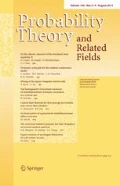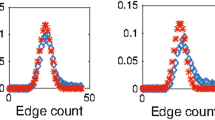Abstract
Define \((X_n)\) on \({\mathbf {Z}}/q{\mathbf {Z}}\) by \(X_{n+1} = 2X_n + b_n\), where the steps \(b_n\) are chosen independently at random from \(-1, 0, +1\). The mixing time of this random walk is known to be at most \(1.02 \log _2 q\) for almost all odd q (Chung, Diaconis, Graham in Ann Probab 15(3):1148–1165, 1987), and at least \(1.004 \log _2 q\) (Hildebrand in Proc Am Math Soc 137(4):1479–1487, 2009). We identify a constant \(c = 1.01136\dots \) such that the mixing time is \((c+o(1))\log _2 q\) for almost all odd q. In general, the mixing time of the Markov chain \(X_{n+1} = a X_n + b_n\) modulo q, where a is a fixed positive integer and the steps \(b_n\) are i.i.d. with some given distribution in \({\mathbf {Z}}\), is related to the entropy of a corresponding self-similar Cantor-like measure (such as a Bernoulli convolution). We estimate the mixing time up to a \(1+o(1)\) factor whenever the entropy exceeds \((\log a)/2\).
Similar content being viewed by others
References
Boucheron, S., Lugosi, G., Massart, P.: Concentration Inequalities. Oxford University Press, Oxford (2013). A nonasymptotic theory of independence, With a foreword by Michel Ledoux
Breuillard, E., Varjú, P.P.: Cut-off phenomenon for the ax+b Markov chain over a finite field (2019). Preprint arXiv:1909.09053v1
Chung, F.R.K., Diaconis, P., Graham, R.L.: Random walks arising in random number generation. Ann. Probab. 15(3), 1148–1165 (1987)
Derriennic, Y.: Quelques Applications du théorème Ergodique Sous-Additif, Conference on Random Walks (Kleebach, 1979) (French), vol. 4, pp. 183–201 (1980)
Friedlander, J., Iwaniec, H.: Opera de cribro, vol. 57. American Mathematical Society, Providence, RI (2010)
Ford, K.: Anatomy of integers and random permutations course lecture notes. https://faculty.math.illinois.edu/ford/Anatomy_lectnotes.pdf
Green, B., Harper, A.J.: Inverse questions for the large sieve. Geom. Funct. Anal. 24(4), 1167–1203 (2014)
Hare, K.E., Hare, K.G., Morris, B.P.M., Shen, W.: The entropy of Cantor-like measures. Acta Math. Hungar. 159(2), 563–588 (2019)
Hildebrand, M.: A lower bound for the Chung–Diaconis–Graham random process. Proc. Am. Math. Soc. 137(4), 1479–1487 (2009)
Hildebrand, M.: On a lower bound for the Chung–Diaconis–Graham random process. Stat. Probab. Lett. 152, 121–125 (2019)
Hildebrand, M.V.: Rates of convergence of some random processes on finite groups, ProQuest LLC, Ann Arbor, MI (1990). Thesis (Ph.D.), Harvard University
Hildebrand, M.: Random processes of the form \(X_{n+1} = a_{n} X_{n} + b_{n}\) (mod p). Ann. Probab. 21(2), 710–720 (1993)
Hall, R.R., Tenenbaum, G.: Divisors, Cambridge Tracts in Mathematics, vol. 90. Cambridge University Press, Cambridge (1988)
Kaĭmanovich, V.A., Vershik, A.M.: Random walks on discrete groups: boundary and entropy. Ann. Probab. 11(3), 457–490 (1983)
Neville III, R.: On lower bounds of the Chung–Diaconis–Graham random process, ProQuest LLC, Ann Arbor, MI (2011). Thesis (Ph.D.), State University of New York at Albany
Steele, J.M.: An Efron–Stein inequality for nonsymmetric statistics. Ann. Stat. 14(2), 753–758 (1986)
Tudesq, C.: Majoration de la loi locale de certaines fonctions additives. Arch. Math. (Basel) 67(6), 465–472 (1996)
Acknowledgements
We thank Kevin Ford for discussions related to Lemma 5.4. We thank Martin Hildebrand and Max Wenqiang Xu for comments and suggestions on an earlier version of this paper. We are grateful to the anonymous referee for carefully reading the paper and for helpful comments.
Author information
Authors and Affiliations
Corresponding author
Additional information
Publisher's Note
Springer Nature remains neutral with regard to jurisdictional claims in published maps and institutional affiliations.
Sean Eberhard and Péter P. Varjú have received funding from the European Research Council (ERC) under the European Union’s Horizon 2020 research and innovation programme (Grant Agreement No. 803711). PV was supported by the Royal Society.
Rights and permissions
About this article
Cite this article
Eberhard, S., Varjú, P.P. Mixing time of the Chung–Diaconis–Graham random process. Probab. Theory Relat. Fields 179, 317–344 (2021). https://doi.org/10.1007/s00440-020-01009-1
Received:
Revised:
Accepted:
Published:
Issue Date:
DOI: https://doi.org/10.1007/s00440-020-01009-1



